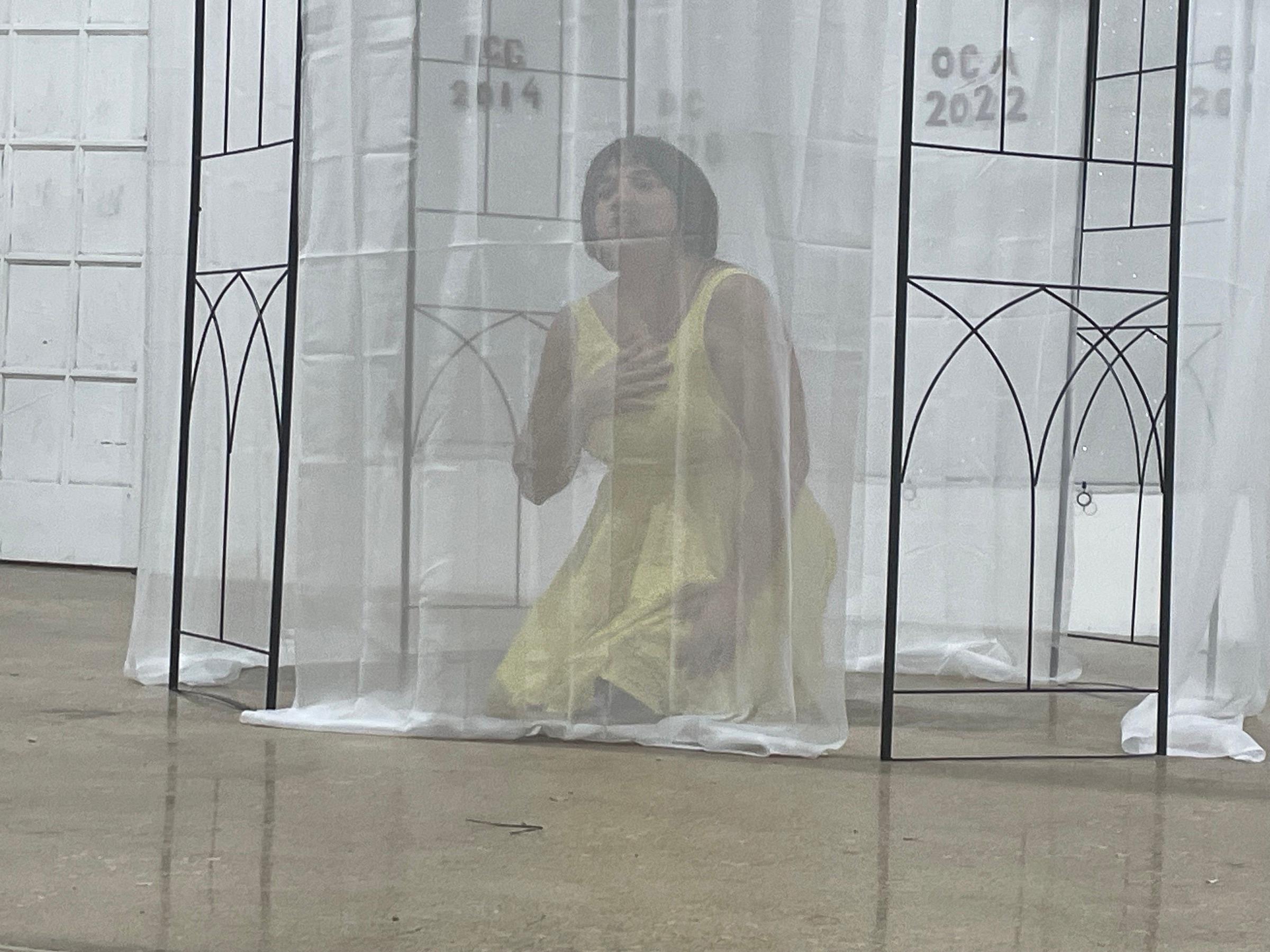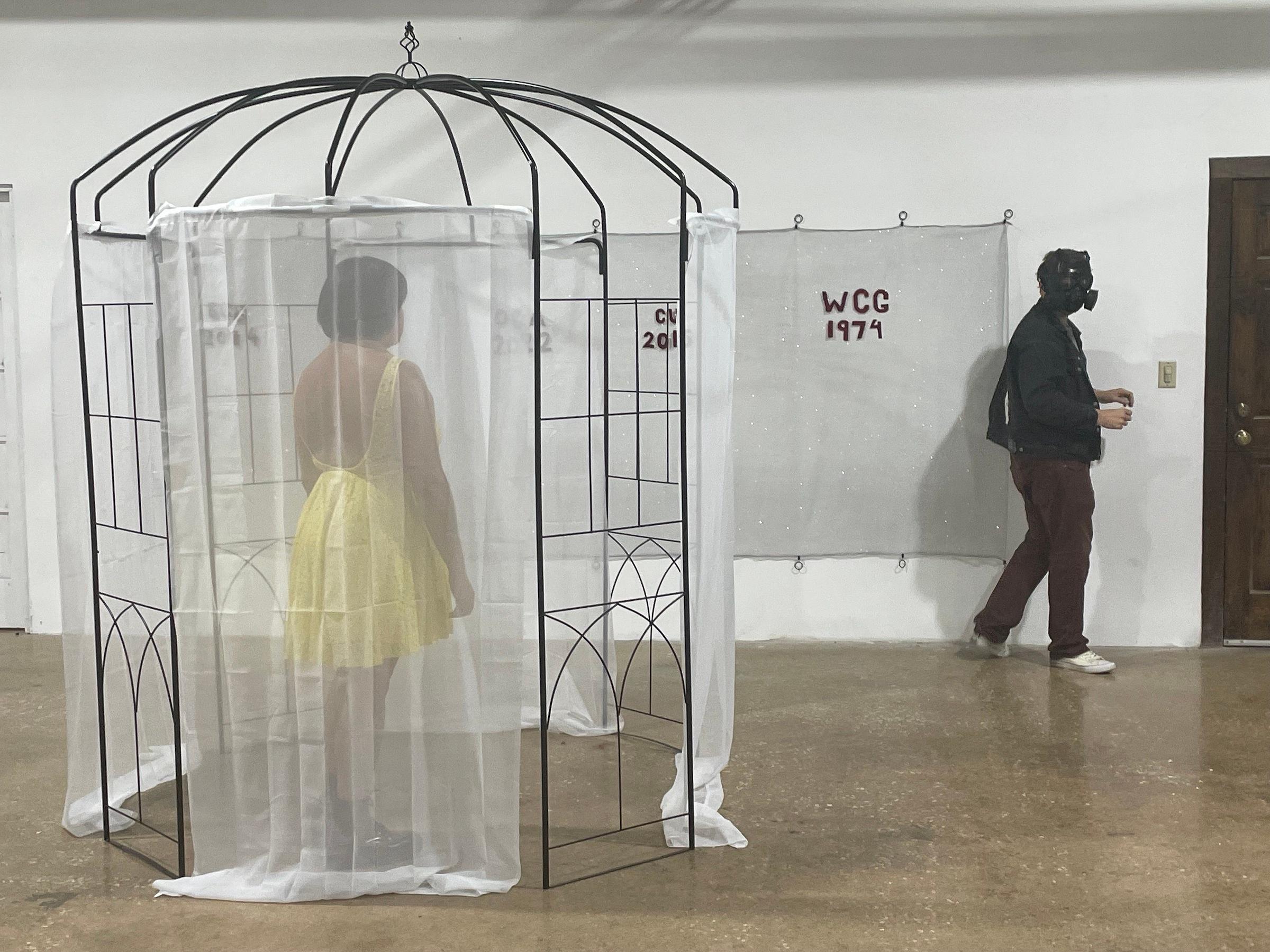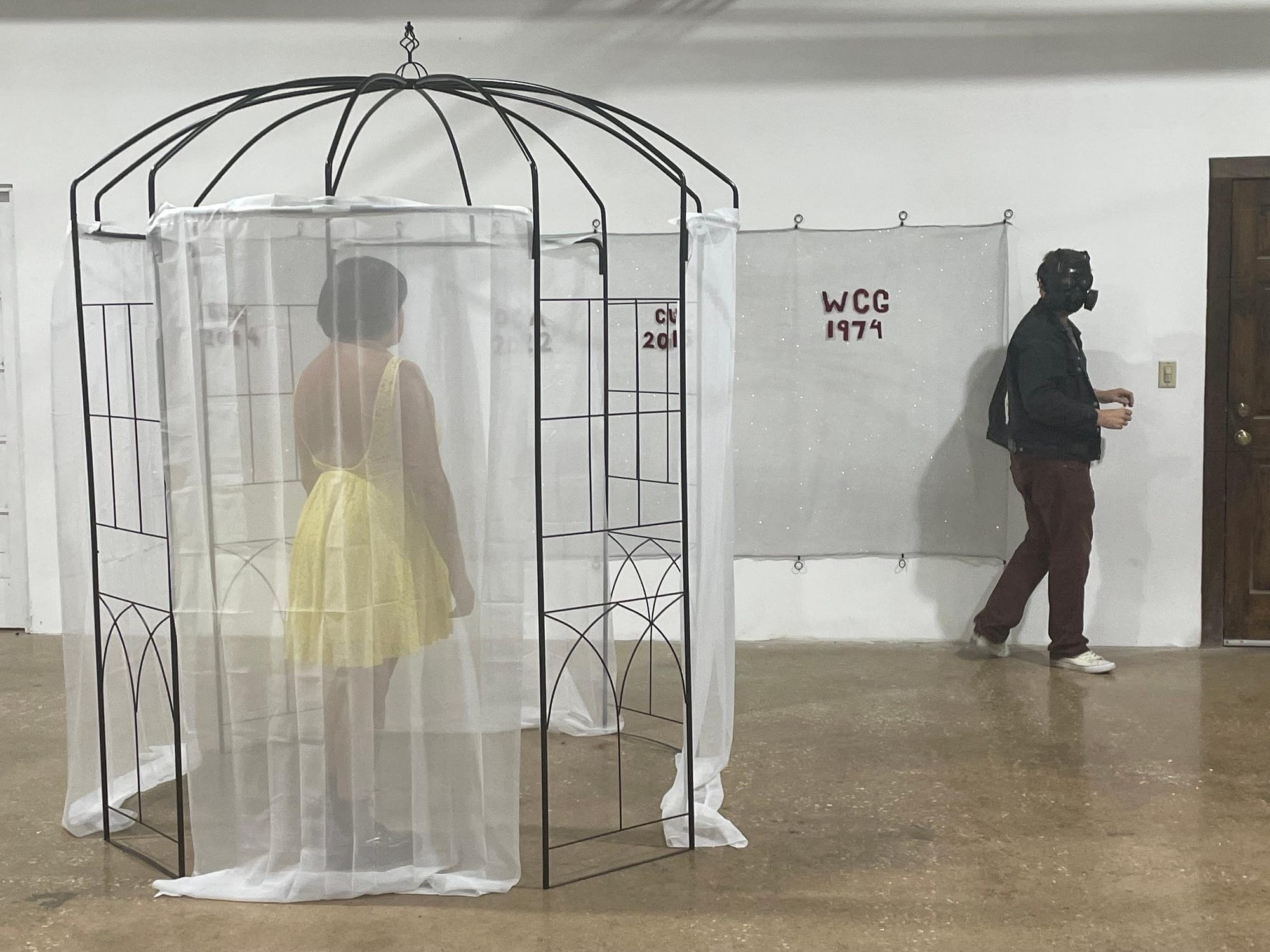The Vibes are Rancid
500x Gallery
Dallas, Texas
Oct. 14, 2023
The Vibes are Rancid, a performance art work by Nora Soto, debuted at 500x Gallery, amid much anticipation. The topic was painfully relevant to her audience of local artists and community organizers: racism and exclusionary practices in commercial art spaces.
Soto has been working three years as an artist and is a member of the 500x Gallery, the longest running artist collective in Texas. She has spent years as an area activist and community organizer. Her artistic practice became another way she could have a voice.
The performance of The Vibes centered around a cage-like gazebo structure standing at the end of the gallery. The cage was draped with white translucent, airy curtains. The tense, haunting cumbia song “Canario,” by Karen y Los Remedios, sank the well-lit stage with dark song lyrics (translated from Spanish to English): “You’ll never change, there is no problem because I will always be the canary.” The audience heard the helpless story of the trapped bird accepting its difficult situation.
Soto appeared from a door in a yellow dress, and made her way into the cage. She was the canary.
She moved around the cage as the music continued, reaching through, displacing the curtains and taking up the space in the cage with large, wing-like movements of her arms.
A second actor, a white man, entered the stage area wearing a gas mask and carrying a grey limp fabric. He began hooking up the material to nails in the wall behind the cage. He didn’t interact with Soto, who was watching him; she began to become frantic as he hung the curtain. She was losing her breath.
The curtain was hung. It was a charcoal grey, with letters and dates in red velvet. Soto read the curtain from her cage and spiraled to the floor, into a pile, limp and unmoving, marking the end of a performance that lasted a little over four minutes.

The performance was simple, poignant, and quick. The crowd was made up of approximately 80 people, all artists, and community organizers. Several approached Soto to learn more about the work and its symbolism.
The Vibes are Rancid, according to Soto, was made for local artists. That’s right, an artist made artwork for other artists, as a warning mechanism.
It’s rare that artists make work for artists. But here in this instance, that is exactly the intent.
“The letters on the curtain are the initials of the galleries and their establishment dates. The galleries that have been racist, known to be racist or exclusive,” said Soto. She described the work as made “to warn others that the environment is toxic.”
At first, someone unfamiliar with performance art may think that the work was without research or merit because of its simplicity. It may be considered “too-on-the-nose,” as Soto put it, in naming the local institutions — because, after all, these institutions do have power over the careers of local artists.

Careful consideration was taken in placing gallery initials on the curtain through collecting stories of other artists, and communities. Her choices were also informed by her own personal experience: “I started conceptualizing this piece after I had an overt racist experience in an art space in Dallas. It was on par with racism I hadn’t felt since I was a teenager. I wanted to take that rage and frustration outside of my body and use it to build awareness within the community.”
Soto has been working three years as an artist and is a member of the 500x Gallery, the longest running artist collective in Texas. She has spent innumerable years as an area activist and community organizer. Her artistic practice became another way she could have a voice and educate locals.
As for The Vibes are Rancid, the curtain’s rollcall is one of holding institutions accountable. “I could have more, it could go on and on. I could keep going. Maybe it’s a piece that will be in process always, and keep adding more places to it. If you want your name off my curtain then you need to come correct,” said Soto. One iteration of the performance Soto considered had the canary being resuscitated, and saved. Perhaps that version of the performance is yet to come, when some the named institutions do correct their practices.
The performance, as it stands, required research and design into the idea of the canary in the coal mine.
“The coal mine is the art scene that we have to do our work in and that we are stuck in. We have to function in it somehow, we don’t have any other opportunities other than to work within this environment and the curtain with the names of the institutions initials is the visual representation of carbon monoxide,” stated Soto.
The toxic, tasteless, invisible gas that would quietly kill miners at work was likened to the harmful, exclusionary practices conducted by the private galleries listed on the curtain that local artists try to work with. Many of the artists in the gallery that night of Soto’s performance came to speak with her and share their stories about invisible lines and hardship in the local art world. If art is made to communicate, and connect people, certainly this performance accomplished that with audience members present.
More intriguing to me, as I listened to Soto speak after the performance, was her accounting of numerous stories about each set of initials on the curtain. The curtain is not only a list of galleries in the area, but a historical inventory of sorts. While many people in DFW have certainly purchased artworks or attended opening of these commercial galleries, this list holds a different set of experiences -– stories of harm, exclusion and racism.
Soto went one step further with her symbolism: “The letters of the initials are red velvet to signify, and represent the red velvet rope that represents exclusion. You’re not allowed into our club – basically.” The classicism tied to the elitism of the galleries is made clear in her fabric choice.
Soto leaned on local artists in the community to help her structure and edit the work so that it could be shared. Political artists often work through symbolism, and suggestion, because the techniques create a message that is more likely to be considered, symbolism makes the message easier to swallow.
No doubt there is a large community in Dallas and Fort Worth that would challenge Soto’s curtain call, and be quickly to defend the local galleries.
However, the simple initials on the curtain don’t represent just the galleries themselves, but the many stories told by local artists of being treated differently for their skin color, identity or class. Soto stood at the curtain with audience members and began listing the names of artists in the room that very night who had contributed their stories to the history of her curtain.
Soto’s work becomes significantly more profound when you begin to ask the question: What is art to artists? In the case of The Vibes are Rancid, it is a historical, living account, a record of stories and a warning. When artists are so strapped in North Texas, working fulltime jobs, being parents and still creating, Soto cautions them on engaging with these local galleries. Risking that hurt is huge. Soto said there is room for galleries to correct harmful practices and potentially be removed from her curtain. Until then, Soto said, “we [will] continue creating our own inclusive spaces and living outside the exploitative environment we are continually forced into.”
Find out more about 500x Gallery here.






